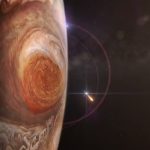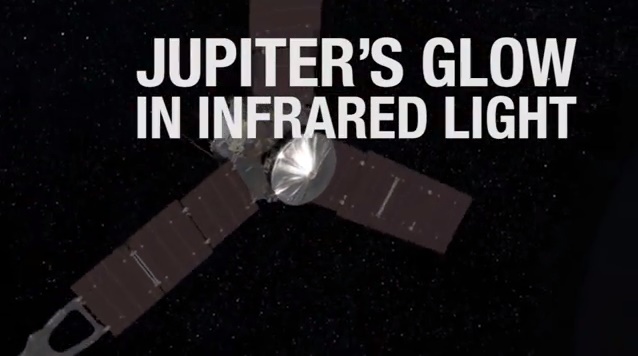This true color mosaic of Jupiter was constructed from images taken by the narrow angle camera onboard NASA’s Cassini spacecraft on December 29, 2000, during its closest approach to the giant planet at a distance of approximately 10 million kilometers (6.2 million miles).
Credits: NASA/JPL/Space Science Institute
このフルカラーの合成画像は、NASAの探査機カッシーニが搭載している狭角カメラで、2000年12月29日に約1,000万キロメートル(6.2百万マイル)の距離から木星を撮影したものです。
7月10日に木星「大赤斑」に最接近して観測
ついにNASAの木星探査機ジュノーが大赤斑に最接近します。
今までジュノーは木星の想像を絶する強大な磁力線や放射線を回避しつつ極から極に周回していましたが、ついに大赤斑の上空にさしかかります。
大赤斑上空約5,600マイル(9000キロメートル)から、ジュノーに搭載している8基の最新観測機器によりデータが取得され、ジュノーカムにより画像撮影されます。謎に満ちた大赤斑の実像が初めて明らかにされるのです。
関連最新木星画像
2017.07.01:地球から赤外線観測した木星の最新画像【静止画】
2017.07.01:地球から赤外線観測した木星の最新画像【動画】
NASAからの発表が待たれます。もちろんこのサイトで速報します!

NASA’s Juno Spacecraft to Fly Over Jupiter’s Great Red Spot July 10
Just days after celebrating its first anniversary in Jupiter orbit, NASA’s Juno spacecraft will fly directly over Jupiter’s Great Red Spot, the gas giant’s iconic, 10,000-mile-wide (16,000-kilometer-wide) storm. This will be humanity’s first up-close and personal view of the gigantic feature — a storm monitored since 1830 and possibly existing for more than 350 years.
NASAの木星探査機ジュノーは、木星軌道に到達した初の記念日を迎えたちょうど数日後に、木星の大赤斑(1万6千キロメートル幅)の巨大な巨大な嵐の上を直接飛行することになります。これは1830年以来350年以上にわたって地球から監視されている特徴的な巨大な嵐であり、おそらく人類史上初の最接近となります。
“Jupiter’s mysterious Great Red Spot is probably the best-known feature of Jupiter,” said Scott Bolton, principal investigator of Juno from the Southwest Research Institute in San Antonio. “This monumental storm has raged on the solar system’s biggest planet for centuries. Now, Juno and her cloud-penetrating science instruments will dive in to see how deep the roots of this storm go, and help us understand how this giant storm works and what makes it so special.”
「ジュピターの神秘的な大赤斑はおそらく木星の最もよく知られた特徴です」とサンアントニオのサウスウエスト研究所のジュノーの主任研究員スコット・ボルトン氏は語りました。 「この壮大な嵐は、太陽系最大の惑星である木星で、数百年にわたり激しさを増しています。今回ジュノーに搭載している大気を調査観測する測定器は、この嵐がどれほど深いところから発生しているかを明らかにし、この特別な巨大な嵐の発生や仕組みを解析する助けとなります。
The data collection of the Great Red Spot is part of Juno’s sixth science flyby over Jupiter’s mysterious cloud tops. Perijove (the point at which an orbit comes closest to Jupiter’s center) will be on Monday, July 10, at 6:55 p.m. PDT (9:55 p.m. EDT). At the time of perijove, Juno will be about 2,200 miles (3,500 kilometers) above the planet’s cloud tops. Eleven minutes and 33 seconds later, Juno will have covered another 24,713 miles (39,771 kilometers) and will be directly above the coiling crimson cloud tops of Jupiter’s Great Red Spot. The spacecraft will pass about 5,600 miles (9,000 kilometers) above the Giant Red Spot clouds. All eight of the spacecraft’s instruments as well as its imager, JunoCam, will be on during the flyby.
大赤斑のデータ収集は、木星を覆う神秘的な大気の頂を6回目となる周回の際に実施されます。木星の中心に最も近い軌道には、PDTで7月10日(月)午後6時55分(EDTで午後9時55分)に到達します。その際ジュノーは木星大気の頂から約2,200マイル(3,500km)の高度にあります。 11分33秒後、ジュノーは木星の大赤斑の真上に位置します。その後24,713マイル(39,771キロメートル)をカバーしながら、大赤斑の上空約5,600マイル(9000キロメートル)を通過します。ジュノーの8基の観測機器とカメラであるジュノーカムは、その間稼働して観測を実施します。
On July 4 at 7:30 p.m. PDT (10:30 p.m. EDT), Juno will have logged exactly one year in Jupiter orbit. At the time, the spacecraft will have chalked up about 71 million miles (114.5 million kilometers) in orbit around the giant planet.
7月4日のPDTで午後7時30分(EDTで午後10時30分)、ジュノーは木星軌道に到達してからちょうど1年となります。当時ジュノーは、巨大な惑星である木星の周りを約7100万マイル(1億1,145万キロ)の軌道を周回していました。
“The success of science collection at Jupiter is a testament to the dedication, creativity and technical abilities of the NASA-Juno team,” said Rick Nybakken, project manager for Juno from NASA’s Jet Propulsion Laboratory in Pasadena, California. “Each new orbit brings us closer to the heart of Jupiter’s radiation belt, but so far the spacecraft has weathered the storm of electrons surrounding Jupiter better than we could have ever imagined.”
Juno launched on Aug. 5, 2011, from Cape Canaveral, Florida. During its mission of exploration, Juno soars low over the planet’s cloud tops — as close as about 2,100 miles (3,400 kilometers). During these flybys, Juno is probing beneath the obscuring cloud cover of Jupiter and studying its auroras to learn more about the planet’s origins, structure, atmosphere and magnetosphere.
Early science results from NASA’s Juno mission portray the largest planet in our solar system as a turbulent world, with an intriguingly complex interior structure, energetic polar aurora, and huge polar cyclones.
JPL manages the Juno mission for the principal investigator, Scott Bolton, of Southwest Research Institute. The Juno mission is part of the New Frontiers Program managed by NASA’s Marshall Space Flight Center in Huntsville, Alabama, for the Science Mission Directorate. Lockheed Martin Space Systems, Denver, built the spacecraft. JPL is a division of Caltech in Pasadena. More information on the Juno mission is available at:
https://www.nasa.gov/juno
http://missionjuno.org
The public can follow the mission on Facebook and Twitter at:
https://www.facebook.com/NASAJuno
Tweets by NASAJuno
DC Agle / Guy Webster
Jet Propulsion Laboratory, Pasadena, Calif.
818-393-9011 / 818-354-6278
agle@jpl.nasa.gov / guy.w.webster@jpl.nasa.gov
Deb Schmid
Southwest Research Institute, San Antonio
210-522-2254
dschmid@swri.org
Dwayne Brown / Laurie Cantillo
NASA Headquarters, Washington
202-358-1726 / 202-358-1077
dwayne.c.brown@nasa.gov / laura.l.cantillo@nasa.gov
2017-186
Last Updated: July 1, 2017
Editor: Tony Greicius










